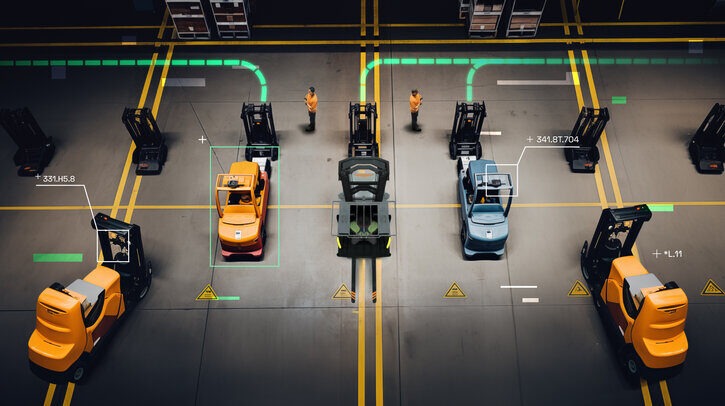The Power of Computer Vision in Enabling Smarter Logistics (Retail & Warehousing)
Computer vision is reshaping logistics for retail and warehousing, leading supply chain services into a new age of accuracy, rapidity, and automated processes. By 2025, more than 65% of logistics service providers and leading retailers operating at echelon 1 will provide full implementation of their AI-driven computer vision systems. Users indicate a peak in efficiency as much as 30%, reductions in labor costs of as much as 20% when using computer vision, and the overall reduction of errors and safety incidents. This radical transformation is taking place in collaboration with a top-tier Computer Vision Development Company and will be powered by integrated AI and Machine Learning Development.
Computer Vision For Logistics: An Overview
Due to rapid ecommerce growth, logistics and retail organizations are under significant pressure to optimize warehouse operations and meet the evolving expectations of consumers. Organizations feel pressure to not only track inventory and keep product quality in order, but also deliver a seamless customer experience while remaining economically viable.
Advanced computer vision technologies, including cameras, AI, and machine learning, transform all visual data into actionable insights. With an AI logistics market that is over $20.8 billion in global sales, the industry is now leveraging computer vision systems to automate inventory management, facilitate cashier-less shopping, and address shrinkage, with the aim to build smarter, data-driven supply chains in a complicated world.
Key Applications of Computer Vision in Warehousing
Computer vision systems drive digital transformation efforts by monitoring, inspecting, and controlling every aspect of the warehousing and distribution that can be made to be immutably and continuously surveilled.
Inventory Monitoring, Management, and Auditing
Computer vision systems continuously observe every area within the storage environment, always counting – and scanning barcodes or QR codes – that are continuously counted, scanned, and logged in an inventory record, and, of course, logged in real time. Drones and/or fixed camera units can collectively aid in the reduction of manual counting and human errors so teams can spend more time on work that generates higher value. These systems can increase the speed of inventory audits to 15 times faster with complete accuracy in real-time, dynamic stock control.
Quality Checks and Damage Notifications
AI-enabled cameras check every item for visible damage, labeling mishaps, or irregularities in packaging – often done before the items even leave for distribution. By implementing machine learning models to identify item images against quality standards, the technology sorts items right away to minimize returns or customer complaints.
Worker Safety and Compliance
Computer vision has capabilities to identify unsafe behaviors, track safety gear compliance, and monitor facility conditions [i.e. temperature, humidity, congestion]. It has the potential to predict the risk of a slip and fall or other unsafe conditions, which can lead to decreased workplace incidents while aiding in regulatory compliance.
Autonomous Guided Vehicles (AGVs) & Robotics Integration
AGVs and robotic pickers utilize vision for recognizing objects in real time and for navigation and handling items. These intelligent robots can operate alongside humans in a safe manner, all while improving through-put, and flexible, scalable design of warehousing.
Automated Order Sorting and Fulfillment
Items are sorted and routed based on size, shape, and destination, all verified through vision. Robots powered by vision can pack, label, and transport products seamlessly through the supply chain, relating to fulfillments that have thousands of items and minimizing error as a single point of inspection—even in high-volume, multi-channel distributions that are complex.
Key Applications of Computer Vision in Retail
Retailers use vision systems to enhance customer experiences and increase operational agility across all touchpoints.
Cashier-less Stores and Automated Checkout
Vision-enabled checkout systems identify products, recognize customer selections, and carry out payments so that shoppers can leave stores without
waiting in line or scanning items. These cashier-less, autonomous solutions are being deployed around this world, reducing labor costs and increasing convenience.
Customer Behavior Analysis & In-store Analytics
Vision analytics can track shoppers’ movement, the time spent at specific products, and sometimes which products were interacted with. This gives managers real-time visibility to reorganize their store layout, stock levels, and staffing to provide a more personalized experience and targeted promotions to improve conversion and customer satisfaction.
Loss Prevention and Theft Detection
AI watches for suspicious behavior and can flag theft, fraud, or mis-scanned items while alerting staff. Retailers with vision-based systems have experienced a decrease in shrinkage and losses by as much as 60%.
Visual Search & Augmented Reality (AR) Shopping
Using smart mirrors, augmented reality displays, and mobile app integration shoppers can visually search for products, try on products virtually, and see online recommendations; bridging online ease of shopping with in-store experience and increasing conversions by as much as 25%.
Benefits of a Smarter Supply Chain
Computer vision affects the supply chain from a lot of different points of views, providing competitive advantage for innovators.
Improved Accuracy and Efficiency
AI-enabled vision systems routinely achieve over 99% inventory accuracy; spotting anomalies, capturing records in real-time, and removing human error. Real-time monitoring provides you with forecasting confidence, and decreases out-of-stock events by over 40%.
Cost Savings
Automating operational processes reduce payroll dollars, theft, and inventory levels; retailers are seeing between 20-30% reduction in labor costs, logistics achieve millions in savings annually from express freight cost and by reducing excess inventory.
Improved Worker Safety
Real-time video analysis can prevent accidents, observe compliance to safety requirements, and quickly identify risks; lowering workplace injuries and providing a safer and supportive work environment.
Real-time visibility and Insight with Data
Computer vision provides continuous operational data, enabling more informed decision-making in forecasting, demand planning, and inventory/ personnel allocation. Companies like Target, DHL and Home Depot are using their vision analytics in real-time to reduce efficiencies in their response time to business disruptions from days to hours while improving customer satisfaction and continuity of service.
The Future of Computer Vision in Logistics: What’s Next?
In the future, the combination of vision, robotics, IoT, and predictive analytics will improve efficiency and agility even more.
Traditional approaches will shift towards autonomous drones, next-generation autonomous guided vehicles (AGVs), and edge-based artificial intelligence (AI), resulting in fully automated plans for receiving, put-away, and fulfillment–as dynamic models using AI will be developed to shift the allocation of resources and shift maintenance in real-time. Retailers will use dynamic multimodal vision, hyper-personalized shopping, visual augmented reality (AR) navigation techniques, and frictionless omni-channel fulfillment, with customers being offered a selection. Sustainability improvements will also occur that improve the smart allocation of energy, reduce waste, change packaging inspection to lessen environmental impacts, and encourage sustainable practices.
Continuing partnerships with experts for custom AI Development Services to scale, will give the company a future-proof and strategic advantage as new methods of industry collaboration develop.
Final Thoughts
Computer vision not only streamlines productivity in logistics; it is revolutionizing warehouses and retailers with an unmatched combination of accuracy, agility and customer experience. Organizations that take advantage of visual intelligence and collaborate with reliable Computer Vision Development service suppliers are seeing enhancements in accuracy, cost reductions, better safety practices, and data-enabled as well as agile operations. The future of logistics is supported by advanced AI Development and advanced Machine Learning Development Solutions that are geared toward automation, intelligence, and the customer experience; a game-changer for global supply chain performance.






